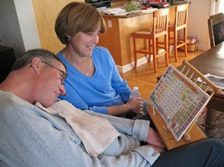Why Use Low Tech?
Low Tech for Reasons of Interdependence

(Click to enlarge).
Working together to create a message, using a laser pointer and a paper communication board.
"What they prize...
(
more and more people with disabilities)
is not self-sufficiency,
but self-determination;
not independence,
but interdependence;
not functional separateness,
but personal connection;
not physical autonomy,
but human community."
Dr. Paul K. Longmore
Historian and disability rights activist
By its very nature, low tech communication requires interdependence. All forms of low tech (other than handwriting) require that a communication partner be present.
For some AAC users, being able to communicate 100% independently 100% of the time is not the highest goal.
INTERDEPENDENCE & EFFICIENCY
For some people, there may be times when the most important thing is to be able to communicate quickly, simply and easily. This may involve working together with a communication partner.
INTERDEPENDENCE & MULTIMODAL COMMUNICATION
Many people may choose to communicate independently at certain times (or for certain activities), but use low tech communication at other times (see examples, below).
INTERDEPENDENCE AND INTERCONNECTEDNESS
Some AAC users value the human connection involved in working together with a communication partner (see examples, below).
As mentioned in the above quote by Dr. Longmore, one of the important things is self-determination. The person with the speech disability chooses the communication method which works best for them at any given time.
Examples of Interdependent Communication
click on green BARS below to open and close
(To open using keyboard commands, tab down to highlight the green bar, then hit "down arrow" key)
Jonathan is a 62 year old attorney diagnosed with ALS. His hands are very weak, but he is able to move his head.
PRIMARY COMMUNICATION
Jonathan uses a head mounted laser pointer and a small communication board for most of his day to day communication. (Jonathan has a speech generating device, but he prefers his low tech system for most of his communication. It’s faster and easier for him and his wife.)
COMPUTER USE (Independent)
Jonathan is able to use the computer independently, using a conventional mouse and an on-screen keyboard. (Jonathan’s hands are very weak. Using the computer is slow, but he is able to do it.)
Jonathan spends several hours on his computer every day, writing emails, working on his book and surfing the internet.
COMPUTER USE (Interdependent)
Jonathan has a college aged daughter, Karen. When Karen visits, she often helps her father with his computer. Jonathan points to letters and words on his communication board, using his laser pointer. Karen types what he is pointing to.
Jonathan is able to independently use the computer. However, it’s faster for him to use his low tech method, and have Karen type for him.
Jonathan and Karen enjoy the human connection of sitting and working together. (For her part, Karen feels that helping her Dad with the computer is a way she can be of service to him.)
Tim has CP (Cerebral palsy). Tim is able to speak, but his speech is very difficult to understand, especially for an unfamiliar listener. Tim’s family is familiar with his speech, and is able to understand most of what he says if they pay attention.
When Tim is out in the community, he uses his speech generating device. When he is at home, he mainly uses speech to communicate. He uses a small alphabet board as a back up for when something he says isn’t understood.
There are times when Tim's mother is multi-tasking (for example, making dinner). At those times, she may ask Tim to use his communication device, so she doesn't have to focus so hard on what he is saying.
Carolyn has advanced stage ALS. She uses a special head mouse to access her computer and communication device. Carolyn spends several hours a day on her computer, writing emails, shopping and managing the family finances.
For most day to day communication, Carolyn uses a large AlphaCore communication board and a laser pointer mounted to her eye glasses.
When Carolyn uses her communication device, it can be a fairly slow process. In the past, when she used her communication device to talk out loud, she noticed that there were times when her communication partner drifted away or started multi-tasking while she was putting her message together.
Carolyn feels that that when she uses low tech, it forces her partners to take a more active role (because the communication partner has to say every word out loud, and write down what she is pointing to.) Carolyn feels that using her low tech board helps keep her communication partners more engaged in the conversation.
Jeanette has bulbar onset ALS (She is able to walk, but is not able to speak.) She uses a keyboard style communication device.
Jeannette uses her communication device for all face to face conversations, and for calling some friends on the phone. She doesn't feel comfortable using her communication device to call unfamiliar people (for example, calling stores, or making appointments.) Jeannette prefers to have her husband or caregiver help with those types of phone calls.

